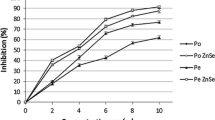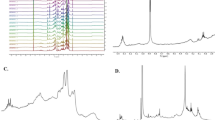Abstract
Mushrooms contain a variety of secondary metabolites, including various phenolic compounds and ergothioneine, which have been shown to act as excellent antioxidants. The present study reports a comparison of the antioxidant properties, total phenolic, ergothioneine and mineral contents of the most-consumed strains of Agaricus bisporus (white or brown colors). The samples were fruiting body, mycelia produced at farm (old mycelium) and in vitro (young mycelium). The antioxidant activity was measured by DPPH, FRAP and ABTS assays. The analysis of phenolic compounds was performed by Folin-Ciocalteau method. The mushroom strain with the highest ergothioneine, phenolic compounds and antioxidant potential was the strain A-SPA15 (brown color). Generally, fruiting body samples revealed higher ergothioneine, phenolic compounds and antioxidant properties than mycelia obtained from farm and in vitro culture. There were variations in the mineral content of A. bisporus harvested from the fruiting body, old mycelium, and young mycelium. Furthermore, the lowest heavy-metal concentrations (Ni, Pb, Cd, and Cr) were detected in mycelium samples in each strain. Results demonstrated that mushrooms contained high amounts of copper, zinc, iron and manganese could be used in well-balanced diets. This study contributes to the data relative to A. bisporus consumed as fresh mushrooms and the possibility of in vitro production as a source of bioactive compounds.
Similar content being viewed by others
Literature Cited
Anne Elise, S.S.C., E.A. Koehnlein, A.A. Soares, G.J. Eler, A.T.A. Nakashima, A. Bracht, and R.M. Peralta. 2012. Bioactives of fruiting bodies and submerged culture mycelia of Agaricus brasiliensis (A. blazei) and their antioxidant properties. LWT — Food Sci. Technol. 46:493–499.
Barros, L., P. Baptista, L.M. Estevinho, and I.C.F.R. Ferreira. 2007. Effect of fruiting body maturity stage on chemical composition and antimicrobial activity of Lactarius sp. mushrooms. J. Agric. Food Chem. 55:8766–8771.
Benzie, I.F.F. and J.J. Strain. 1996. The ferric reducing ability of plasma (FRAP) as a measure of ‘antioxidant power’: The FRAP assay. Anal. Biochem. 239:70–76.
Bernas, E., G. Jaworska, and Z. Lisiewska. 2006. Edible mushrooms as a source of valuable nutritive constituents. Acta Sci. Pol. Technol. Aliment. 5:5–20.
Bozin, B., N. Mimica-Dukic, I. Samojlik, and E. Jovin. 2007. Antimicrobial and antioxidant properties of Rosemary and Sage (Rosmarinus officinalis L. and Salvia officinalis L., Lamiaceae) essential oils. J. Agric. Food Chem. 55:7879–7885.
Chen, S., K. Ho, Y. Hsieh, L. Wang, and J. Mau. 2012. Contents of lovastatin, g-aminobutyric acid and ergothioneine in mushroom fruiting bodies and mycelia. LWT — Food Sci. Technol. 47:274–278.
Cheung, L.M., P.C.K. Cheung, and V.E.C. Ooi. 2003. Antioxidant activity and total phenolics of edible mushroom extracts. Food Chem. 81:249–255.
Dimitrios, B. 2006. Sources of natural phenolics antioxidants. Trends in Food. Sci. Technol. 17:505–512.
Dore, C., T.C.G. Azevedo, M.C.R. De Souza, L.A. Rego, J.C.M. De Dantas, and F.R.F. Silva. 2007. Antiinflammatory, antioxidant and cytotoxic actions of betaglucan-rich extract from Geastrum saecatum mushroom. Int. ImmunoPharmacol. 7:1160–1169.
Dubost, N.J., R. Beelman, D. Peterson, and D. Royse. 2007. Identification and quantification of ergothioneine in cultivated mushrooms using liquid chromatography-mass spectroscopy. Int. J. Med. Mushrooms 8:215–222.
European Commission. 2003. Opinion of the scientific committee on food on the tolerable upper intake level of copper. Health and Consumer Protection Directorate-General, Brussels, Belgium.
Ey, J., E. Schomig, and D. Taubert. 2007. Dietary sources and antioxidant effects of ergothioneine. J. Agric. Food Chem. 55:6466–6474.
Faccin, L.C., F. Benati, V.P. Rincao, M.S. Mantovani, S.A. Soares, and M.L. Gonzaga. 2007. Antiviral activity of aqueous and ethanol extracts and of an isolated polysaccharide from Agaricus brasiliensis against poliovirus type 1. Lett. Appl. Microbiol. 45:24–28.
Gao, H., T.F. Shupe, T.L. Eberhardt, and C.Y. Hse. 2007. Antioxidant activity of extracts from the wood and bark of Port OrFord cedar. J. Wood Sci. 53:147–152.
Garcia-Lafuente, A., C. Moro, A. Villares, E. Guillamón, M.A. Rostagno, and D.M. Arrigo. 2010. Mushrooms as a source of anti-inflammatory agents. Antiinflamm. Antiallergy. Agents. Med. Chem. 9:125–141.
Genccelep, H, Y. Uzun, Y. Tunçtürk, and K. Demirel: 2009. Determination of mineral contents of wild-grown edible mushrooms. Food Chem. 1033–1036.
Ghahremani-majd, H., F. Dashti, D. Dastan, H. Mumivand, J. Hadian, and M. Esna-Ashari. 2012. Antioxidant and antimicrobial activities of Iranian mooseer (Allium hirtifolium Boiss) populations. Hort. Environ. Biotechnol. 53:116–122.
Hartman, P.E., 1990. Ergothioneine as antioxidant. Methods in Enzymol. 186:310–318.
Kim, M.Y., P. Seguin, J.K. Ahn, J.J. Kim, S.C. Chun, and E.H. Kim. 2008. Phenolic compound concentration and antioxidant activities of edible and medicinal mushrooms from Korea. J. Agric. Food Chem. 56:7265–7270.
Koyyalamudi, S.R., S. Jeong, S. Manavalan, B. Vysetti, and G. Pang. 2013. Micronutrient mineral content of the fruiting bodies of Australian cultivated Agaricus bisporus white button mushrooms. J. Food Compos. Anal. 31:109–114.
Isiloglu, M., F. Yilmaz, and M. Merdivan. 2001. Concentrations of trace elements in wild edible mushrooms. Food Chem. 73:163–175.
Lindequist, U., T.H.J. Niedermeyer, and W.D. Jülich. 2005. The pharmacological potential of mushrooms. Evid.BasedComplement. Alternat. Med. 2:285–299.
Mattila, P., K. Könkö, M. Eurola, J.M. Pihlava, J. Astola, L. Vahteristo, V. Hietaniemi, J. Kumpulainen, M. Valtonen, and V. Piironen. 2001. Contents of vitamins, mineral elements, and some phenolic compounds in cultivated mushrooms. J. Agric. Food Chem. 49:2343–2348.
Mattila, P., K. Suonpaa, and V. Piironen. 2002. Functional properties of edible mushrooms. Nutrition. 16:694–696.
Mau, J.L., H.C. Lin, and S.F. Song. 2002. Antioxidant properties of several specialty mushrooms. Food Res. Int. 35:519–526.
Ozturk, M., M. Duru, S. Kivrak, N. Mercan-Dogan, M.A. Özler, and A. Türkoglu. 2011. In vitro antioxidant, anticholinesterase and antimicrobial activity studies on three Agaricus species with fatty acid compositions and iron contents: A comparative study on the three most edible mushrooms. Food Chem. Toxicol. 49:1353–1360.
Paul, B.D. and S.H. Snyder. 2010. The unusual amino acid L-ergothioneine is a physiologic cytoprotectant. Cell Death Differ. 17:1134–1140.
Rahman, I., P.S. Gilmour, L.A. Jimenez, S.K. Biswas, F. Antonicelli, and O.I. Aruoma. 2003. Ergothioneine inhibits oxidative stressand TNF-a-induced NF-jB activation and interleukin-8 release in alveolar epithelial cells. Biochem. Biophys. Res. Commun. 302:860–864.
Rajesh, B.D. and G.R. Nageswara. 2013. Antioxidant properties and electrochemical behavior of cultivated commercial Indian edible mushrooms. J. Food Sci. Technol. 50:301–308.
Slinkard, K. and V.L. Singleton. 1997. Total phenol analysis: Automation and comparison with manual methods. Am. J. Enol. Vitic. 28:49–55.
Yang, J.H., H.C. Lin, and J.L. Mau. 2002. Antioxidant properties of several commercial mushrooms. Food Chem. 77:229–235.
Yen, G.C. and H.Y. Chen. 1995. Antioxidant activity of various tea extracts in relation to their antimutagenicity. J. Agric. Food Chem. 43:27–32.
Author information
Authors and Affiliations
Corresponding author
Rights and permissions
About this article
Cite this article
Ghahremani-Majd, H., Dashti, F. Chemical composition and antioxidant properties of cultivated button mushrooms (Agaricus bisporus). Hortic. Environ. Biotechnol. 56, 376–382 (2015). https://doi.org/10.1007/s13580-015-0124-z
Received:
Revised:
Accepted:
Published:
Issue Date:
DOI: https://doi.org/10.1007/s13580-015-0124-z




